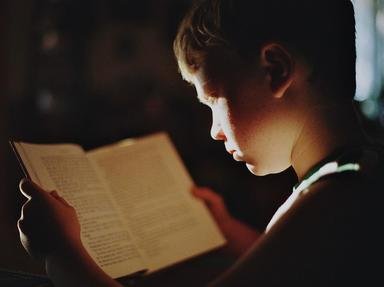Quiz Answer Key and Fun Facts
1. Disney's "The Hunchback of Notre Dame" (1996) was based on Victor Hugo's 1831 novel of that name. Always looking for a happy ending, Disney's writers ensured that the film ended with Quasimodo being hailed a hero in the outside world, having saved the gypsies from Frollo's plans to destroy the Court of Miracles and helped Esmerelda escape. Which less-happy events actually occurred in the book?
2. "My Sister's Keeper" (2009) was based on the 2004 novel of the same name by Jodi Picoult. It follows the life of Anna, a child brought into the world to act as a genetic match and donor for her older sister Kate, who suffers from leukemia. Anna fights for medical emancipation when her parents attempt to force her to donate a kidney to Kate.
In the film, Kate dies before the outcome of Anna's case is revealed, but in the novel Kate lives. What is the actual ending included in the novel?
3. "I am Legend" (2007) is based on a 1954 horror fiction novel by Richard Matheson. It follows Robert Neville, a military virologist who finds himself the last healthy and immune human in New York City after a genetically-engineered variant of the measles virus wipes out 90% of the human population and renders many others vampiric mutants. In the movie, Neville is saved by a fellow survivor, Anna, who inadvertently leads the infected masses to his home, where he must detonate a grenade, ending his own life, in order to save Anna and her son who then retreat to a survivors' colony with the antidote. What actually happens in the novel?
4. "Hannibal" (2001) is based on the Thomas Harris novel of the same name. Set ten years after "Silence of the Lambs", it follows Clarice Starling's attempts to apprehend Hannibal Lecter before Mason Verger, his last surviving victim, kills him. The film ends with Lecter's escape on a plane whilst Clarice, unable to catch him, is left to continue her search. What actually happened in the novel?
5. "Forrest Gump" (1994) is based on Winston Groom's 1986 novel of the same name.
There are a number of differences between the two versions of the story, the ending being just one. At the end of the film, Forrest and Jenny have reunited and she has introduced him to his son. Jenny dies of an undisclosed virus (most likely HIV), leaving Forrest to raise their son. How did the novel end?
6. Although the endings of the "Harry Potter" films have generally remained true to those of the books, there is a slight discrepancy in relation to "Harry Potter and the Prisoner of Azakaban" (2004). At the very end of the film, following his escape, Sirius Back sends Harry a Firebolt racing broom. How does this differ from JK Rowling's 1999 novel?
7. "The Shining" (1980) was based on the Stephen King 1977 horror novel of the same name. It famously starred Jack Nicholson as Jack Torrance, a writer who becomes a janitor at an isolated hotel and gradually descends into madness following the discovery of his son's psychic abilities and a snowstorm that traps his family in the hotel. The film ends with Jack, in his madness, killing chef Dick Hallorann before pursuing his son through a hedge maze. Eventually, his wife and son escape, leaving Jack to slowly freeze to death in the maze. Stephen King did not like the ending of the film. How did his novel end?
8. "The Wizard of Oz" (1932), famously starring Judy Garland as Dorothy, was actually based on Frank L. Baum's 1900 children's novel of the same name. In the movie, Dorothy returns home by clicking together her Ruby Slippers and saying "There's no place like home". She is then reunited with her family and farmhands, though no mention is made of what happened to her friends the scarecrow, tin man and lion (other than that they may not have existed other than in a dream). How does the novel really end?
9. There have been many film adaptations of HG Wells' 1898 novel "War of the Worlds", but the 2005 film of the same name, starring Tom Cruise, was a blockbuster. In both versions, the invading aliens eventually die from Earth-based diseases due to their lack of immunity from bacteria we encounter every day. The film ends with Ray, the protagonist, taking his daughter to his ex-wife's house in Boston, finding her, her parents and his son alive and well. How does this differ to the novel?
10. Dan Brown's 2000 novel "Angels and Demons" was, following the success of the "Da Vinci Code" adapted into a movie starring Tom Hanks as Robert Langdon and Ewan McGregor as Camerlengo McKenna (Ventresca in the novel). In both versions, the Camerlengo is shown to have murdered the previous Pope and planted the threatening antimatter in an attempt to be hailed a hero and elected the new Pope. However, the film omitted which interesting information from the ending of the novel?
Source: Author
suzidunc
This quiz was reviewed by FunTrivia editor
agony before going online.
Any errors found in FunTrivia content are routinely corrected through our feedback system.

